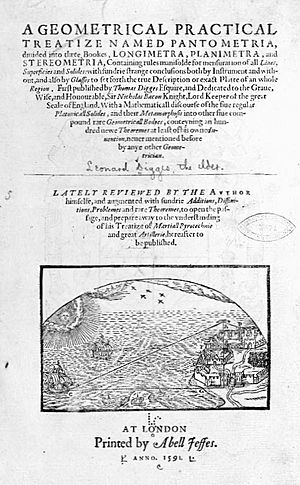Leonard Digges (scientist) facts for kids
Quick facts for kids
Leonard Digges
|
|
|---|---|
| Born | c.1515 |
| Died | c.1559, aged 44 |
| Parent(s) | James Digges, Philippe Engham |
Leonard Digges (around 1515 – around 1559) was a smart English mathematician and surveyor. He is known for inventing the theodolite, a tool used for measuring angles in surveying. He also helped make science popular by writing books in English about surveying, map-making (cartography), and military engineering. He was likely born around 1515 or 1520.
His son, Thomas Digges, continued his work, adding to and publishing many of Leonard's ideas. Thomas also played a big part in sharing the ideas of Nicolaus Copernicus's famous book, De revolutionibus orbium coelestium, which was about how planets move. In 1570, Thomas wrote about how Leonard Digges used a "proportional Glass" to see faraway objects and people. Some historians think this might describe an early telescope built between 1540 and 1559, but it's not certain.
Contents
About Leonard Digges
Leonard Digges was born around 1515. He was the only son of James Digges, a respected gentleman from Kent, England. His mother was Philippe Engham. His father, James Digges, had been the High Sheriff of Kent in 1510–11. This was an important local government role.
In 1542, Leonard Digges visited Guînes Castle with some friends. They impressed their host by showing off their skills in geometry, navigation, measurement, and how to use artillery.
Involvement in a Rebellion
In January 1554, Digges took part in a rebellion led by Sir Thomas Wyatt. This group was against the marriage of England's new Catholic Queen, Mary I, to Philip II of Spain. Digges was found guilty of a serious crime against the government and was sentenced to death.
However, he was pardoned on April 1, 1554. Even though he was pardoned, his land and belongings, which had been taken, were kept until he paid a large fine. In February 1555, Digges was fined 400 marks. He paid this off in parts, and the fine was fully cleared on May 7, 1558. Leonard Digges is thought to have died around 1559.
His Family
Leonard Digges married Bridget Wilford. They had three sons and three daughters:
- Thomas Digges, who became a famous mathematician like his father. Thomas's children included Sir Dudley Digges (a politician) and Leonard Digges (writer) (a writer).
- James Digges
- Daniel Digges
- Mary Digges
- Anne Digges
- Sarah Digges
His Scientific Books
Leonard Digges's first book was A General Prognostication, published in 1553. It became very popular because it included a perpetual calendar (a calendar that works for any year), weather predictions, and lots of information about astronomy. Before this, such information was mostly found in books written in Latin or Greek.
The book was updated in 1555 and again in 1556, with the new title A Prognostication everlasting. Later editions, from 1576 onwards, included extra material written by his son, Thomas.
The Telescope Idea
Some people believe Leonard Digges might have invented the reflecting telescope or the refracting telescope. He needed to see accurately over long distances for his surveying work. In the 1591 book Pantometria, which was based on his father's notes, Thomas Digges praised his father's achievements.
Thomas wrote that his father, using his knowledge of geometry, could figure out the sizes, distances, and movements of the Sun, Moon, planets, and stars. He also claimed that his father, using "proportional Glasses" (lenses), could not only see things far away but also read letters and count coins from a distance. He even claimed his father could see what was happening in private places seven miles away!
William Bourne, a colleague of Digges, also wrote about experiments with lenses and mirrors that Leonard and his son did. These writings made some researchers, like Colin Ronan, think that Leonard Digges invented a working telescope between 1540 and 1559.
However, making lenses and mirrors with enough precision in the 16th century would have been very hard. It's unlikely that Digges built a successful instrument that could perform as well as claimed. Seeing details on coins in a field or private activities seven miles away was far beyond the technology of that time.
Honours
Digges Cove in Antarctica is named after Leonard Digges.


